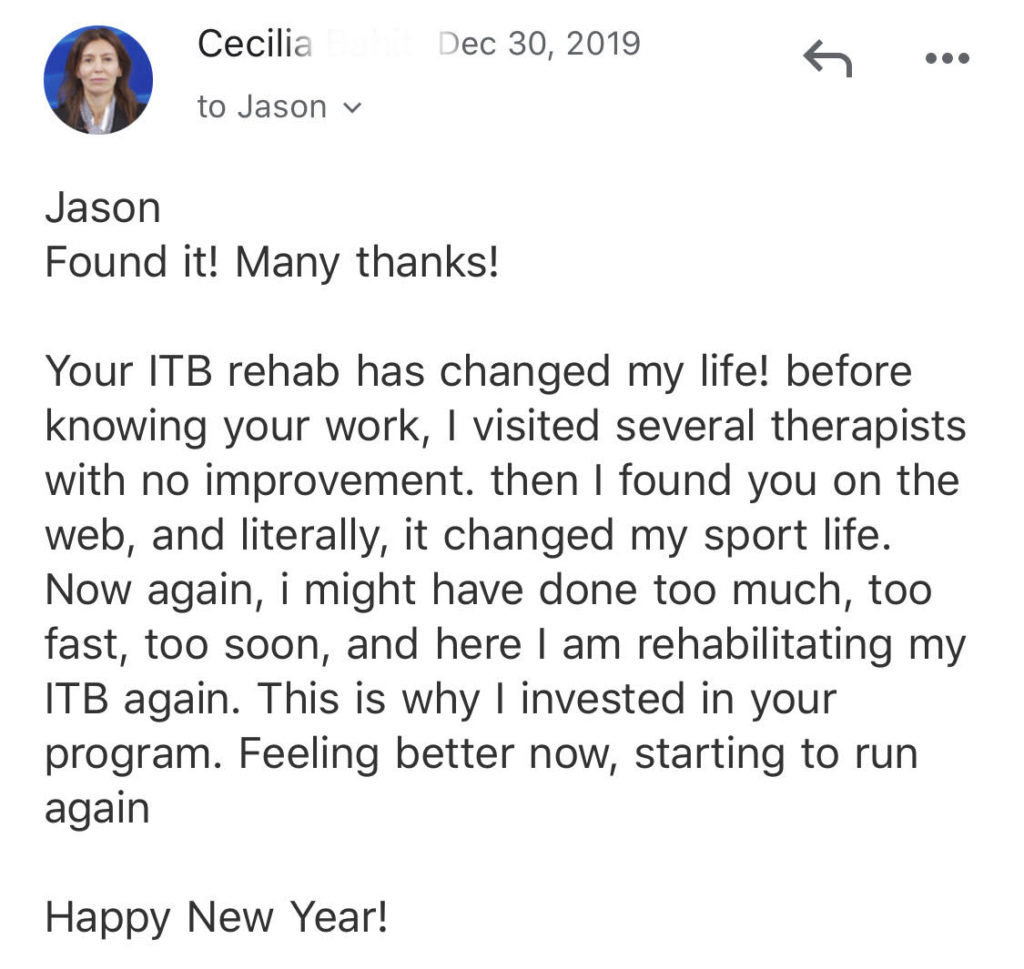IT Band Syndrome (ITBS) is one of the most frustrating injuries for runners. But there’s a way to run pain-free again!

I know a thing or two about having an injured IT band. After I ran the New York City Marathon in 2008, I had a severe case of ITBS after the race. I took 9 days off from running after the race and then started to slowly run a little bit, only to have sharp pain on the outside of my left knee a few miles into a run.
I couldn’t run for six months and spent most of that time on the couch, watching reruns of House while eating sleeves of Oreos…
Eventually, I saw a physical therapist. But that didn’t help at all. So I saw another… and another…
After seeing four physical therapists and spending countless hours researching the best treatment programs for IT Band Syndrome, I finally understood the injury.
And once I understood why ITBS occurs, I was ready to treat it and start running healthy.
The ITB Rehab Routine
The result of my six months of misery is the ITB Rehab Routine. This strength protocol strengthens the glutes, hips, and quadriceps and allowed me to finally resume training after six months of inactivity.
More importantly, this routine teaches your body how to move, giving you:
- Better control over the rotation of the femur (it shouldn’t collapse inward)
- A more stable pelvis, resulting in less hip drop
- Higher levels of running economy (efficiency) due to less wasted movement
Even though my IT Band injury has fully healed, I still do this routine because I think hip strength is very important to runners. New research shows that weak hips are to blame for other leg injuries (not just ITBS). Even if you don’t have IT band syndrome, this is still a very fundamental routine that every runner can benefit from!
More aggressive rehabilitation for IT Band injuries can be done in the gym with dead lifts and squats to strengthen the glutes, which are often weak in distance runners and the reason the IT Band can get inflamed.
Note that this routine is not a complete rehabilitation program for IT Band Syndrome. This is just one piece of the puzzle.
Treating IT Band Syndrome
The ITB Rehab Routine consists of nine exercises done in a row with minimal rest. I do one set. Below is a demonstration of the exercises, using a Thera-Band.
- Lateral Leg Raises: lie on your right side with a theraband around your ankles. Lift your left leg to about 45 degrees in a controlled manner, then lower. I do 30 reps per side.
- Clam Shells: lie on your right side with your knees together and a theraband around your lower thighs. Your thighs should be about 45 degrees from your body and your knees bent at 90 degrees. Open your legs like a clam shell but don’t move your pelvis – the motion should not rock your torso or pelvic girdle. Keep it slow and controlled. I do 30 reps on each leg.
- Hip Thrusts: lie on your back with your weight on your upper back your feet. Your legs will be bent at the knee. Lift one leg so your weight is all on one leg and your back. Lower your butt almost to the ground and thrust upward by activating your glutes. This exercise is great for glute strength and hip stability. I do 25 reps on each leg.
- Side Hip Bridge: Lie on your side with your feet propped on an elevated surface about 1-2 feet high. Push your bottom foot down and lift your torso using your hip muscles while maintaining a stable spine. Return to the starting position.
- Side-Steps / Shuffle: with a theraband around your ankles and knees slightly bent, take ten steps laterally. The band should be tight enough so it provides constant resistance during all steps. Still facing the same direction, take another 10 steps back to your starting position. That is one set. I like to do 5 sets. This exercise will look like a slow-motion version of a basketball “defense” drill.
- Pistol Squats: These are simply one-legged squats. The key to a successful pistol squat is to not lean forward, keep the motion slow and controlled, and make sure your knee does not collapse inward.
- Hip Hikes: Stand on your right foot. With your pelvis in a neutral position, drop the left side so it is several inches below the right side of your pelvic bone. Activate your right hip muscle and lift your left side back to its neutral position. I do 20 reps per side.
- Iron Cross: This dynamic stretch will help you feel loose after the previous strength exercises. Lie on your back with your arms out to your sides and swing your right leg over your torso and up to your left hand. Repeat with your left leg and do 20 reps in total.
- Scorpion: Lie in a prone position with your arms out to your sides and swing your right leg across your back up to your left hand. Keep your shoulders and chest as flat against the ground as possible. Like Iron Cross, there will be a good amount of rotation in your torso and hips as you swing your leg toward your hand. Repeat the same movement for the opposite leg.
After my experience paying an exorbitant copay to go to a physical therapist twice every week, this video is easily worth hundreds of dollars to the runner who applies it to their case of IT Band Syndrome. If you use a foam roller for myofascial release after the routine, you are getting almost all of the benefits of a PT without the cost.
The only thing you need is a good Thera-Band.
Questions About the ITB Rehab Routine?
Here are a few things to keep in mind when doing this strength routine.
How often can I do these ITBS exercises?
If you currently have ITB pain, you can do this routine as often as every other day (but this is not a complete treatment program – other strength work is likely needed).
If you’re not currently injured, complete this routine 1-2 times per week. The other days can be dedicated to other strength routines or a weightlifting workout in the gym.
This routine is best saved for after a run; as a more formal strength session, it should aways be done after a run so the main exercise (running) is prioritized. And it acts as a great warm-down after a tough workout or long run.
Can I do this routine even if I don’t have IT Band Syndrome?
Yes! In fact, I consider this routine fundamental to the health of distance runners. It focuses on building strength and efficient movement patterns in the hips and glutes – two of the most important muscles for runners.
These muscles are critical because they’re two of the biggest muscles in the leg that directly control the running stride. If they’re weak, imbalanced, or don’t function properly, they’ll result in slower and injured runners.
What if I can’t do pistol squats (one-legged squats)?
If you can’t do pistol squats, start by putting a chair or bench behind you. Practice sitting and getting up on one leg until that gets easier. Then, use a lower chair or stack of books to make it more difficult. With practice, you’ll eventually be able to perform a pistol squat without any assistance.
This exercises relies on a high level of neuromuscular control. While you might feel awkward at first, improvements in neuromuscular fitness occur quickly. Within a few weeks, you’ll be substantially better!
What Resistance Level is recommended for the Thera-Bands?
Most runners are better off getting the low/medium resistance Thera-bands at first (or a combo pack so you can progress).
But if you think you’re stronger or have experience with similar exercises for the hips, you can start at a medium or high resistance.
Any Other Tips for IT Band Syndrome?
The number of reps and the recovery period is not set in stone. Please modify this routine if you need to! It’s far better to start doing the routine consistently at half the reps, than not complete it at all.
You can also increase the number of repetitions or add weight (by holding a kettlebell or other weight for some exercises or using a higher resistance Thera-band).
Most runners aren’t following a formal, runner-specific strength program. This routine is one component of a successful strength program that prioritizes injury prevention, builds strength in the specific areas that runners need, and helps improve performance.
Injured? Or Tired of Injuries?

Running injuries like IT Band Syndrome can be the most frustrating aspect of being a runner. They prevent you from doing what you love: running!
But with a focus on prevention and aggressive treatment for your illiotibial band syndrome, you’ll be on the road with a smile on your face sooner than ever.
Sign up here to get custom illustrations of this routine and I’ll also send you:
- Our most popular email course on injury prevention
- More strength routines just like the ITB Rehab Routine
- Mistakes to avoid that result in injuries like ITBS
- Case studies, benefits of staying healthy, and more!
ITBS can be a stubborn injury so it’s important to treat it quickly, aggressively, and with no mercy.
The ITB Rehab Routine is one piece of that puzzle. Get the illustrations to the routine here.